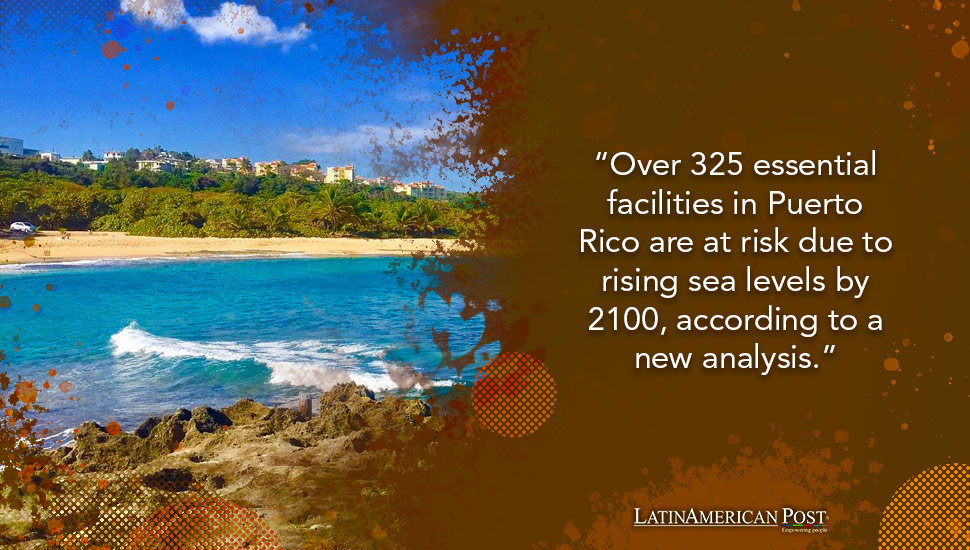Coastal Infrastructure at Risk from Rising Seas in Puerto Rico

Over 325 essential facilities in Puerto Rico are at risk due to rising sea levels by 2100, according to a new analysis. This highlights the urgent need for comprehensive solutions to protect the island’s vital infrastructure from climate change impacts
A recent analysis by the Union of Concerned Scientists (UCS) has raised the alarm about the vulnerability of essential infrastructure in Puerto Rico to rising sea levels. The study “Looming Deadlines for Coastal Resilience,” led by climate scientist Kristina Dahl, reveals that by 2100, up to 325 essential facilities on the island could face frequent flooding. This projection underscores the urgent need for proactive measures to safeguard Puerto Rico’s critical infrastructure against the escalating threats posed by climate change.
According to the study, by 2050, up to 28 essential facilities in Puerto Rico could be inundated twice a year on average, with 20 of these at risk of flooding every two weeks. By the end of the century, this number could rise to 325, with around 300 experiencing bi-weekly floods. These alarming figures are part of a broader trend affecting 1,100 critical infrastructure sites along the U.S. coasts, which could see monthly flooding by 2100 based on a median sea level rise.
The UCS defines essential infrastructure as facilities providing necessary functions to maintain daily life or those posing significant risks to society if flooded. This includes residential areas, industrial sites, and public utilities crucial for the well-being and safety of communities. For Puerto Rico, the potential impact of rising sea levels is particularly severe given its geographic and socio-economic context.
Kristina Dahl’s analysis projects a global average sea level rise of 3.2 feet (97.5 centimeters) by 2100. Such an increase would submerge vast coastal areas and exacerbate the frequency and severity of storm surges and high tides. “Our analysis indicates that by 2030, there will be a 20% increase in essential infrastructure at risk of repetitive flooding along U.S. coasts compared to 2020 conditions,” Dahl stated.
As a U.S. territory, Puerto Rico ranks seventh in the nation for infrastructure at risk of damaging floods by 2100. This ranking highlights the island’s heightened vulnerability and the pressing need for targeted adaptation and mitigation strategies. The UCS recommends that authorities begin planning and investing now to protect vital coastal infrastructure, emphasizing that delaying action could result in significantly higher costs and more severe consequences in the future.
Socio-Economic Implications
The looming threat of sea level rise poses significant socio-economic challenges, particularly for disadvantaged communities. According to Juan Declet-Barreto, a senior social scientist specializing in climate vulnerability at UCS and a report co-author, marginalized communities will have twice as much essential infrastructure at risk as non-marginalized communities by 2050. This disparity underscores the need for equitable climate resilience planning that prioritizes the most vulnerable populations.
Nine communities in Puerto Rico are expected to have essential infrastructure at risk of flooding from 2024 to 2050. By 2100, this number is projected to rise to 35. Moreover, the number of essential facilities under threat is anticipated to increase by more than 55% by 2050 and by 18 times by 2100 compared to 2020.
The report highlights that the most vulnerable infrastructures are public housing and industrial sites with contamination risks. Frequent flooding in these areas could lead to hazardous conditions, including the spread of pollutants and increased health risks for residents. Therefore, addressing these vulnerabilities is an environmental imperative and a public health and social justice issue.
Implementing Comprehensive Solutions
Given the severity of the threat, it is crucial to implement comprehensive solutions to protect Puerto Rico’s coastal infrastructure. This requires a multi-faceted approach that includes both short-term and long-term strategies.
Investment in Resilient Infrastructure: One of the most effective ways to combat the impacts of rising sea levels is by investing in resilient infrastructure. This includes constructing sea walls, improving drainage systems, and elevating buildings and critical infrastructure. Natural solutions such as restoring mangroves and wetlands can provide significant protection by absorbing storm surges and reducing coastal erosion.
Equitable Climate Resilience Planning: Ensuring that climate resilience efforts prioritize the needs of marginalized communities is essential. This involves inclusive planning processes that engage affected communities in decision-making and provide them with the resources and support needed to adapt. Equitable resilience planning helps to address existing inequalities and ensures that the benefits of climate adaptation are shared broadly.
Strengthening Regulatory Frameworks: Governments and regulatory bodies must enforce stringent building codes and land-use regulations that account for future climate risks. This includes restricting development in high-risk areas and ensuring that new construction meets high resilience standards. Strengthening rules can prevent future vulnerabilities and protect lives and property.
Innovative Financing Mechanisms: Securing adequate funding for climate resilience projects is a significant challenge. Innovative financing mechanisms, such as public-private partnerships and climate resilience bonds, can provide the capital for large-scale adaptation efforts. International climate finance can also support developing regions, including Puerto Rico, in their resilience-building initiatives.
The Role of Regional Collaboration
Addressing the impacts of climate change on coastal infrastructure is not a challenge that Puerto Rico faces alone. Similar vulnerabilities exist across Latin America, where many countries grapple with rising sea levels and increased storm intensity. Regional collaboration can enhance resilience by sharing knowledge, resources, and best practices.
For instance, countries in the Caribbean and Latin America can work together to develop regional climate adaptation plans that address common challenges. Collaborative research initiatives can improve understanding of local climate impacts and inform more effective adaptation strategies. Furthermore, regional partnerships can leverage international support and funding to implement large-scale resilience projects.
The Inter-American Development Bank (IDB) and other regional organizations can facilitate these efforts by providing technical assistance, financial support, and platforms for collaboration. By working together, countries in the region can enhance their collective resilience and better protect their coastal communities and infrastructure.
A Call to Action
The findings of the UCS report serve as a stark reminder of the urgent need for proactive measures to address the impacts of rising sea levels on essential infrastructure in Puerto Rico and beyond. The projections for 2050 and 2100 highlight the escalating risks and underscore the importance of immediate action.
Policymakers, planners, and community leaders must prioritize climate resilience in their agendas and work collaboratively to implement practical solutions. This includes investing in resilient infrastructure, prioritizing the needs of vulnerable communities, and strengthening regulatory frameworks to prevent future vulnerabilities.
Public awareness and engagement are also critical components of successful climate resilience efforts. Educating communities about the risks and involving them in the planning process can foster a sense of ownership and encourage collective action. Puerto Rico can develop a more resilient and prepared society by building a shared understanding of the challenges and opportunities.
Also read: Exploring Puerto Rico’s Pre-Hispanic Heritage in Caguana
The threat of rising sea levels to Puerto Rico’s essential infrastructure is a pressing issue that demands comprehensive and coordinated action. By adopting forward-thinking strategies and fostering regional collaboration, Puerto Rico can protect its vital infrastructure and ensure a sustainable future for its communities. The lessons learned, and solutions developed here can serve as a model for other regions facing similar challenges, contributing to a more resilient and adaptive world in the face of climate change.





